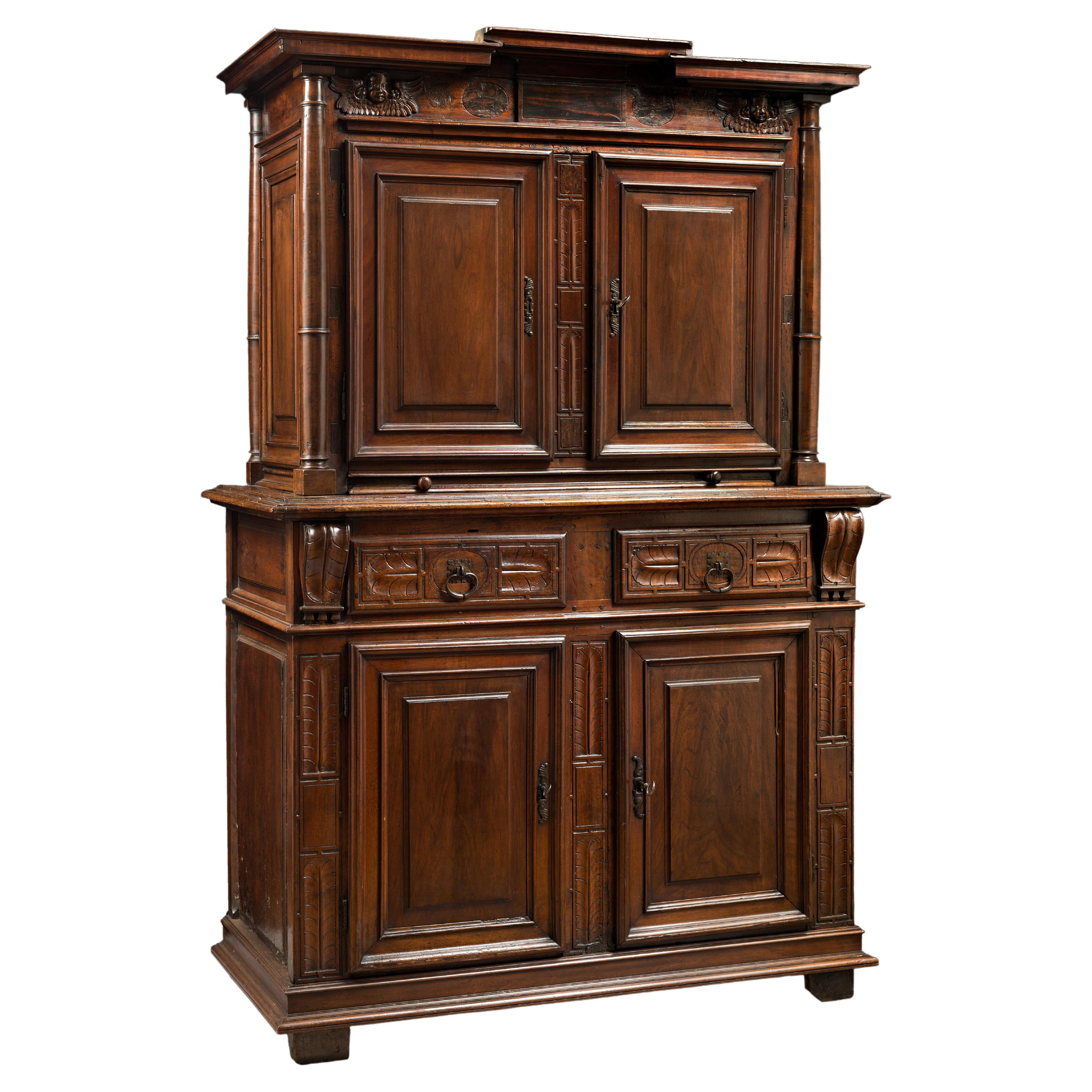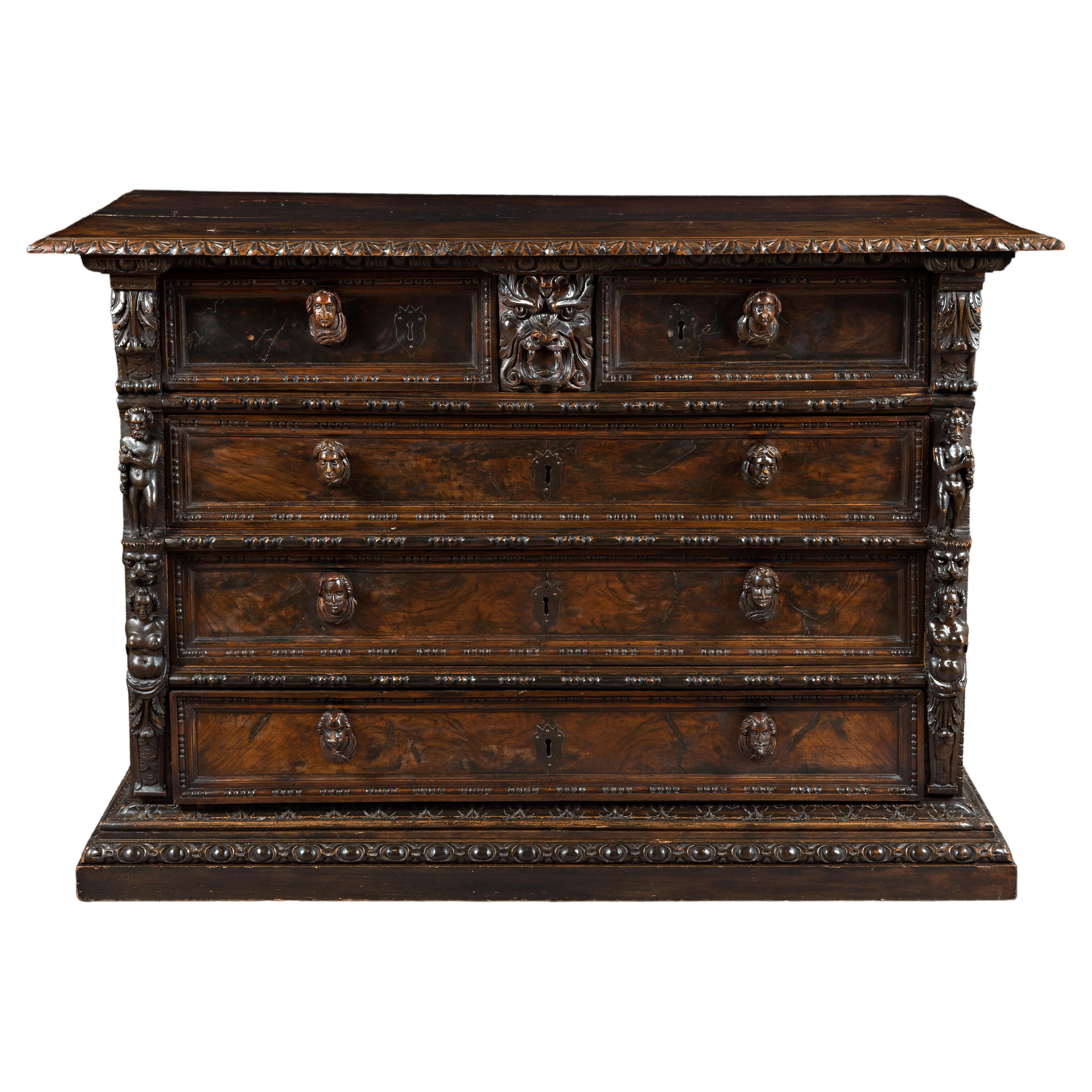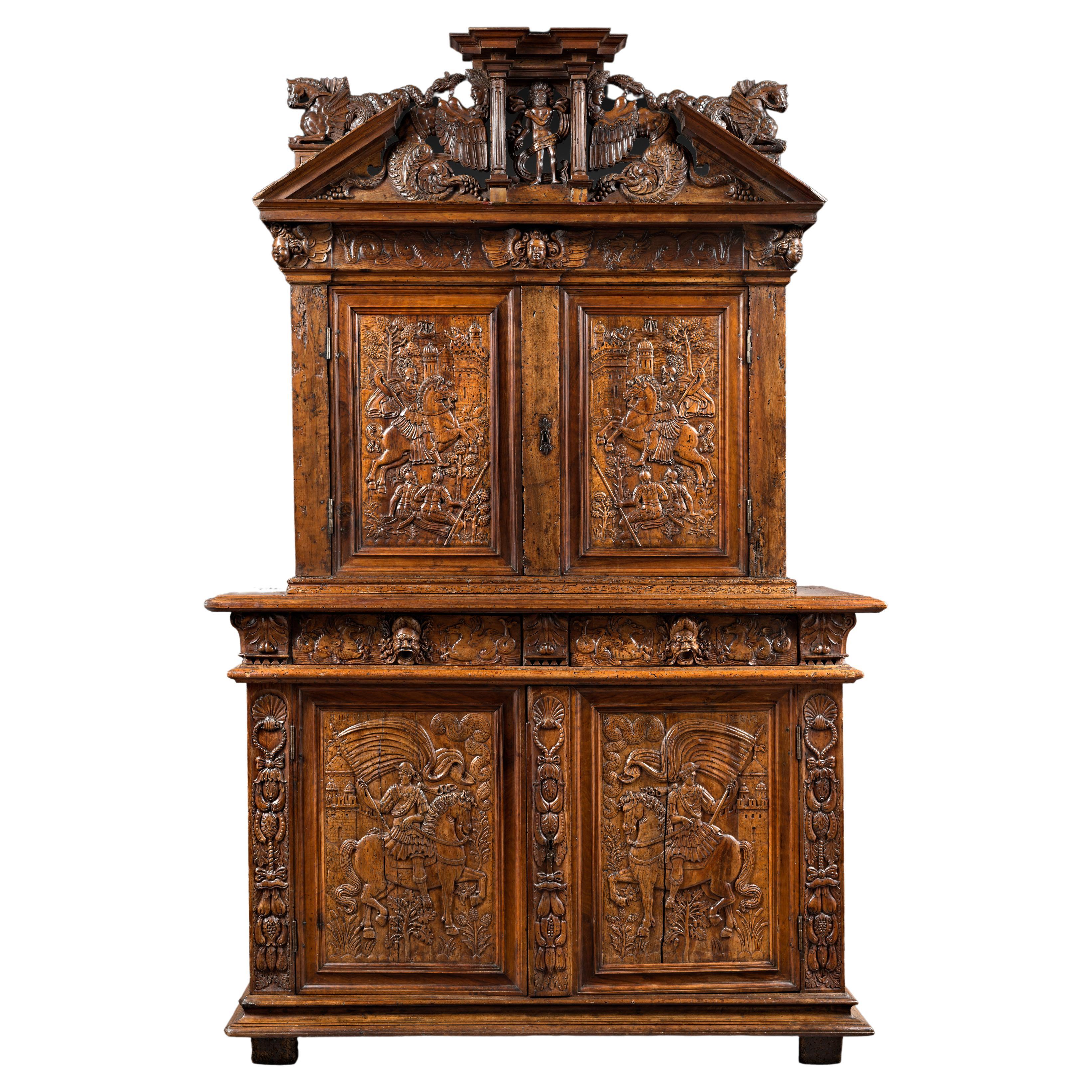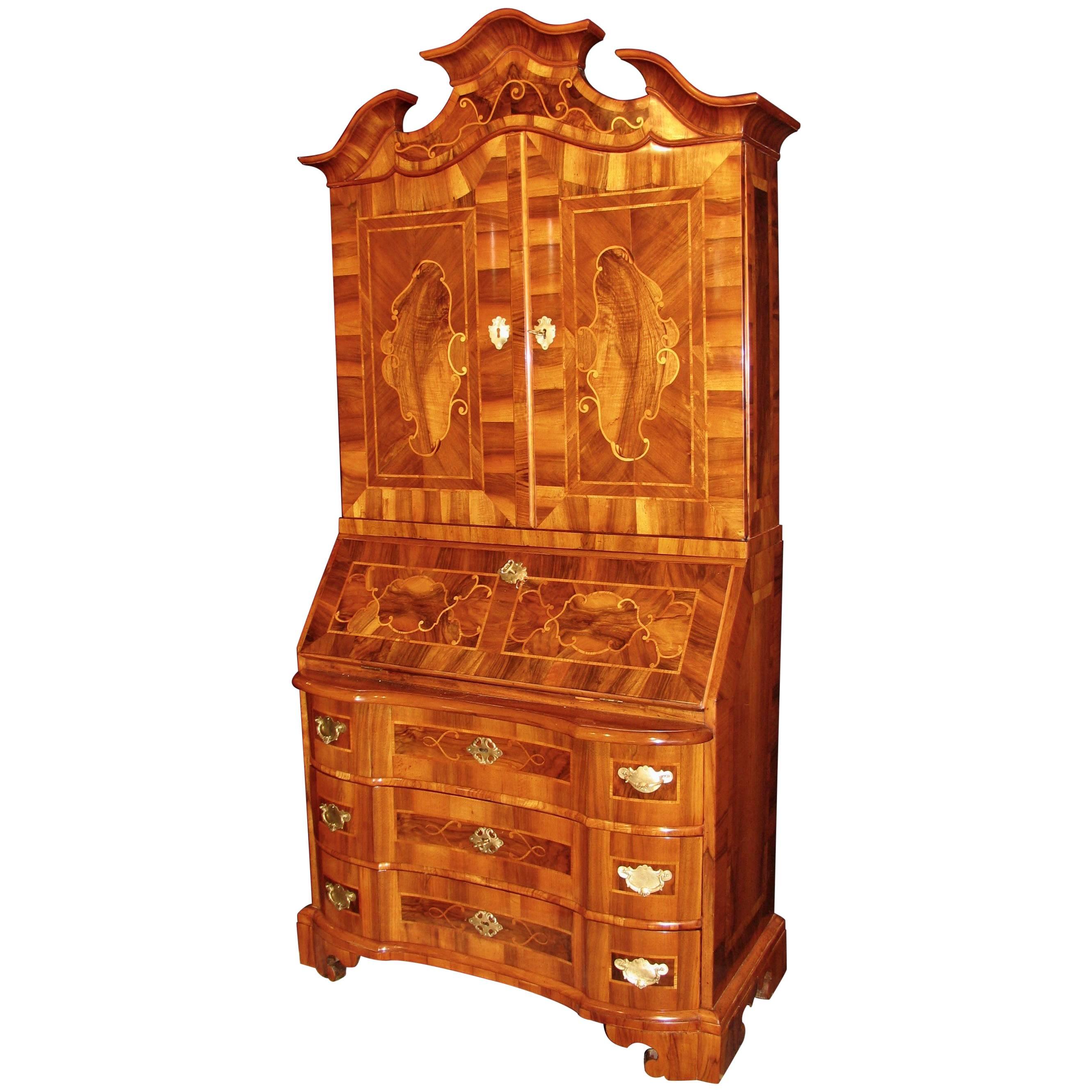Items Similar to 16th Century Two Bodied Genoan "Stipo" Cabinet with a Bambocci Decor
Want more images or videos?
Request additional images or videos from the seller
1 of 5
16th Century Two Bodied Genoan "Stipo" Cabinet with a Bambocci Decor
About the Item
This stipo, little Italian cabinet made of walnut and walnut burl, is a remarkable example of Mannerism applied to decorative arts during the late 16th century.
While the Mannerist movement was born and developed in Florence before becoming international, it is in Northern Italy that Mannerism fully bloomed during the late 16th and early 17th century.
Contrary to the rest of Italy where classical motifs are adopted very early on, Renaissance decorative elements persist very late all through the 17th century in the Northern regions.
It is in Liguria that this fashion appears the most clearly on furniture and especially in Genoa where appears a whole category of cabinets with richly carved decor of exuberant figures called bambocci. This specifically Genoan type of furniture draws inspiration from Tuscan Mannerism.
This Genoan cabinet is made of two superimposed bodies. The frame is ornated with small figures and fruit and flower garlands executed with virtuosity in a block of walnut wood then applied on each jamb. Inspired by bambocci those figures celebrate life and the deities of nature.
The lower body stands on a moulded base supported by beautiful overlapping lion paws. It opens with two door-leaves. The finely moulded arches' spandrels are garnished with foliage. On each side are carved small naked female figures covering themselves with their hands in an harmonious pose. They stand on angel heads and flower bouquets. In the angles rise two thin grooved columns.
The belt comprises two drawers flanked by atlant putti carved on top of modillions.
The upper body is framed by two admirable grooved columns identical to those on the lower body. The jambs are adorned with sheathed caryatids standing on angel heads and foliated scrolls.
In the centre is an admirable architectonic decor revealing an Antique portico with a triangular pediment. A draped woman holds in her hand a palm leaf. On both sides are located foor drawers as well as a door-leaf where a naked woman takes place in a niche.
The entablature is divided by three atlant putti topping the cabinet. The cabinet is finished by a dentil frieze.
On the lateral panels of the lower body moulded frames animate the surface while on the upper body they are adorned with an arcature, foliages granishing the spandrels. As on the facade the cornice is supported by putti.
Bibliography
Silvano Colombo, L'arte del mobile in Italia, Bramante Editrice, 1981
Augusto Pedrini, Il Mobilio gli ambienti e le Decorazioni del Rinascimento in Italia, Stringa Editore, 1969.
- Dimensions:Height: 72.84 in (185 cm)Width: 44.89 in (114 cm)Depth: 20.48 in (52 cm)
- Style:Renaissance (Of the Period)
- Materials and Techniques:
- Place of Origin:
- Period:16th Century
- Date of Manufacture:16th Century
- Condition:
- Seller Location:Saint-Ouen, FR
- Reference Number:1stDibs: LU3115327312212
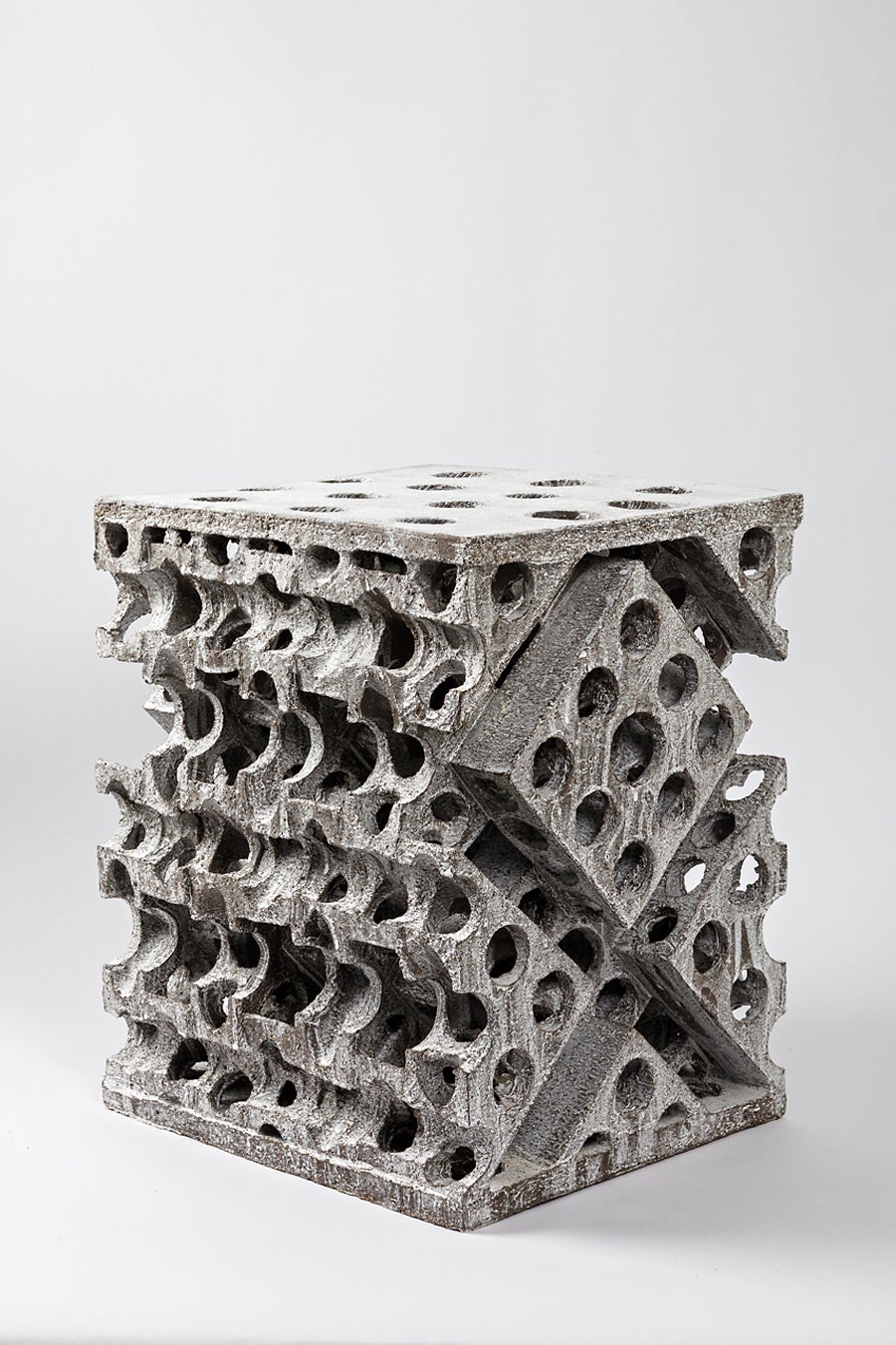
About the Seller
5.0
Vetted Seller
These experienced sellers undergo a comprehensive evaluation by our team of in-house experts.
Established in 2016
1stDibs seller since 2017
157 sales on 1stDibs
Typical response time: 8 hours
- ShippingRetrieving quote...Ships From: Saint-Ouen, France
- Return PolicyThis item cannot be returned.
More From This SellerView All
- 16th Century Renaissance Two-Bodied CabinetLocated in Saint-Ouen, FRFormer collection Altounian At the beginning of the reign of Henri II (1547-1559) the furniture’s ornamentation evolves. The few medieval motifs that were still used are eventually relinquished. Furniture becomes more sober showcasing moulded panels and perfect architecture. Cabinet-makers use ornaments such as curved fluted or plain columns, feather quills, roses or winged putti heads. High-relief carving becomes more scarce and compositions lighter. To that end cabinet-makers draw inspiration from Fontainebleau motifs filtering them and adapting them to French taste. During this period cabinet-makers turn into a kind of architects. Indeed the architectural balance of furniture is the centre of their concerns. The study of Antic formulas is then a necessity. From this care given to proportions appear refined cabinets with pure lines. This style is characteristic of the reign of Henri II and disappears soon after under the regency of Catherine de Medici (1560-1574) when an abundance of high and low-relief ornaments comes back on furnitures. This two-bodies cabinet...Category
Antique 16th Century French Renaissance Cabinets
MaterialsWalnut
- Late 16th Century Genoan Bambocci Chest of DrawersLocated in Saint-Ouen, FRProvenance: Gismondi collection, before 1973. Historical Context This walnut wood and walnut burl cassetone is a remarkable example of Mannerist art applied to furniture in the late 16th century. While the Mannerist movement appeared and grew in Florence before acquiring its international stature it also spread to Northern Italy as soon as the late 16th century early 17th century. To the opposite of the rest of Italy where classic motifs are adopted very early, northern regions maintain the use of Renaissance motifs very late all through the 17th century. Sculpture now leaving the austere environment of churches and civil buildings appear in private homes where it graces state rooms and studies. This craze is particularly expressed on furniture from Liguria and particularly in Genoa where are produced highly carved furnitures with figures and spectacular decors called bambocci. This typically Genoese pieces express nonetheless a Florentine origin through Mannerism. Description This Genoese chest is framed by small figures skilfully carved from one wood chunk...Category
Antique 16th Century Italian Renaissance Commodes and Chests of Drawers
MaterialsWalnut
- 16th Century French Walnut Cabinet with Marble InlaysLocated in Saint-Ouen, FROn the left post of the lower body, is written the date 1596 in a cartouche This cabinet has two bodies. The upper part, set back, is moulded and carved. At the bottom, the cabine...Category
Antique 16th Century French Renaissance Cabinets
MaterialsWalnut
- 16th Century French Carved Renaissance CabinetLocated in Saint-Ouen, FRRare carved Renaissance cabinet Period : 2nd half 16th century, ca. 1570 Origin : France, Burgundy or Languedoc This cabinet embody the produ...Category
Antique 16th Century French Renaissance Cabinets
MaterialsWalnut
- 16th Century Cabinet with Knights Carving from Avignon Workshops 'France'Located in Saint-Ouen, FRCollection Jean Thuile Around the mid-sixteenth century French furnishing evolves in its conception and ornamentation. The start of major archi...Category
Antique 16th Century French Renaissance Cabinets
MaterialsWalnut
- Small Two-Body Buffet Decorated with Bird QuillsLocated in Saint-Ouen, FRSmall two-body buffet decorated with bird feathers ORIGIN : FRANCE PERIOD : 16th CENTURY Measures: height: 170 cm length: 106 cm depth: 51 cm Walnut wood This cha...Category
Antique 16th Century Renaissance Cabinets
MaterialsWalnut
You May Also Like
- 18th Century Baroque Cabinet with Secretaire, Germany, 1760Located in Belmont, MA18th century Baroque cabinet with secretaire, Germany, 1760, walnut veneer. Beautiful piece in excellent condition, professionally rest...Category
Antique 1760s German Baroque Cabinets
MaterialsWalnut
- 20th Century Dutch Writing Cabinet, 1960sLocated in Den Haag, NLDutch writing cabinet hand built by a master craftsman, circa 1960s featuring ornate inlay work and numerous drawers and compartments. Very impressive piece and great quality.Category
Mid-20th Century Dutch Louis XVI Cabinets
MaterialsWood
- 16th Century Portuguese Wooden CabinetLocated in High Point, NCHandsome and dignified, this antique Provincial cabinet combines understated simplicity with a beautiful auburn finish. Made in Portugal in the 16th century, paneled doors unlock wit...Category
Antique 16th Century Portuguese Country Cabinets
MaterialsWood
- Early 20th Century Italian Louis XV Style Cabinet with Writing DeskLocated in Casale Monferrato, ITElegant Italian Louis XV Style cabinet with desk 1910s. This cabinet is characterized by a refined veneer in fine rosewood. The veneer is laid using the grain of the wood as a decora...Category
Vintage 1910s Italian Louis XV Cabinets
MaterialsWalnut
- Early 18th Century French Petite Secretaire or Bureau with Projecting CabinetLocated in Los Angeles, CAEarly 18th-century French dark wood secretary or fall-front bureau cabinet with charming proportions. Featuring a carved projecting cornice and arched front, original glass mirror fr...Category
Antique 18th Century and Earlier French Secretaires
MaterialsWood
- 20th Century Italian Louis XV Style Inlaid Walnut Cabinet with Writing DeskLocated in Casale Monferrato, ITElegant cabinet in precious inlaid walnut 1930s. This cabinet is characterized by a refined inlay work with neoclassical decorations. The inlay is made using many different precious ...Category
Vintage 1930s Italian Louis XV Cabinets
MaterialsWalnut
